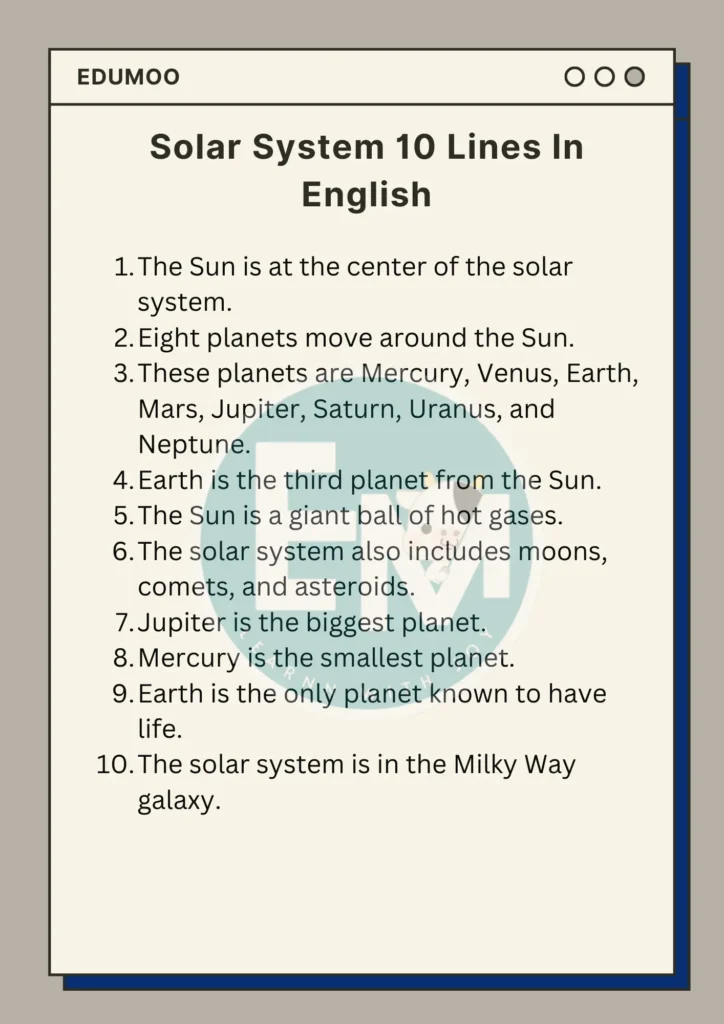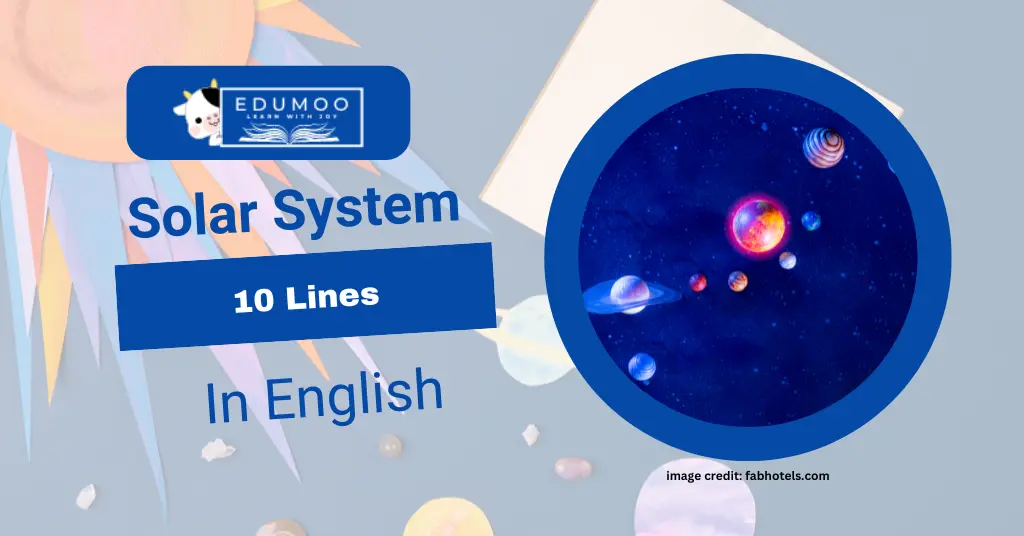The solar system is a fascinating part of our universe that has the Sun at its center. Surrounding the Sun are eight unique planets, each with its own features and characteristics. From the smallest planet Mercury to the largest planet Jupiter, the solar system is full of wonders. Learning about the solar system helps us understand more about our own planet, Earth, and the amazing universe we live in. Join us on this journey as we explore the basic facts about the solar system 10 lines in a simple and fun way!
Solar System 10 Lines In English
- The Sun is at the center of the solar system.
- Eight planets move around the Sun.
- These planets are Mercury, Venus, Earth, Mars, Jupiter, Saturn, Uranus, and Neptune.
- Earth is the third planet from the Sun.
- The Sun is a giant ball of hot gases.
- The solar system also includes moons, comets, and asteroids.
- Jupiter is the biggest planet.
- Mercury is the smallest planet.
- Earth is the only planet known to have life.
- The solar system is in the Milky Way galaxy.

Essay On Solar System In English In 300 Words
The solar system is a big and interesting part of our universe. In the middle of the solar system is the Sun, a huge ball of hot gases that gives light and heat to all the planets. There are eight planets in our solar system, and they all travel around the Sun. These planets, in order from the Sun, are Mercury, Venus, Earth, Mars, Jupiter, Saturn, Uranus, and Neptune.
Mercury is the nearest planet to the Sun and is also the tiniest. Venus, the second planet, is similar in size to Earth but has a very thick and toxic atmosphere. Earth, our home planet, is the third planet from the Sun and the only one known to support life. Mars, the fourth planet, is known as the Red Planet because of its reddish appearance.
Jupiter, the fifth planet, is the largest in the solar system and has a Great Red Spot, which is a giant storm. Saturn, the sixth planet, is famous for its beautiful rings made of ice and rock. Uranus, the seventh planet, is unique because it rotates on its side. Neptune, the eighth and farthest planet from the Sun, is known for its deep blue color and strong winds.
Besides the planets, the solar system also includes moons, comets, asteroids, and dwarf planets like Pluto. Moons orbit around the planets, and there are many in our solar system. For example, Earth has one moon, while Jupiter has over 70.
Studying the solar system helps us understand more about the universe and our place in it. Each planet and object in the solar system has unique features that make it interesting. From the heat of the Sun to the icy rings of Saturn, the solar system is full of wonders waiting to be explored. By learning about the solar system, we can appreciate the beauty and complexity of the universe and inspire future explorations.
| Also Read: Agra Fort 10 Lines |
Essay On Solar System In English In 900 Words
The solar system is a fascinating and vast part of our universe, with the Sun at its center. The Sun is a gigantic ball of hot, glowing gases that gives us light and heat. It is so large that around 1.3 million Earths could fit inside it! The Sun is important because it provides the energy that supports life on Earth and keeps the planets in their orbits.
There are eight main planets in our solar system. Each planet orbits, or travels around, the Sun in a path called an orbit. The planets are split into two groups: the inner planets and the outer planets. The inner planets, which are closer to the Sun, include Mercury, Venus, Earth, and Mars. These planets are mainly made of rock and metal. The outer planets, which are farther from the Sun, are Jupiter, Saturn, Uranus, and Neptune. They are farther from the Sun and are much larger, made mostly of gases and liquids.
Mercury is the closest planet to the Sun and is also the smallest planet in the solar system. It has a very thin atmosphere, so it cannot trap heat. This means that Mercury has extreme temperatures, very hot during the day and very cold at night. Venus, the second planet from the Sun, is similar in size to Earth but has a very thick and toxic atmosphere made mostly of carbon dioxide. This thick atmosphere traps heat, making Venus the hottest planet in the solar system.
Earth, the third planet from the Sun, is where we live. It is the only planet we know of that has life. The air around Earth contains different gases, including oxygen, which we need to live. Earth has one moon that circles around it. The fourth planet, Mars, is often called the Red Planet because of its reddish appearance, which comes from iron oxide, or rust, on its surface. Mars has the largest volcano and the deepest, longest canyon in the solar system. It also has two small moons.
Jupiter is the fifth planet from the Sun and the biggest one in the solar system. It is so big that all the other planets could fit inside it! Jupiter is known for its Great Red Spot, a massive storm that has been raging for hundreds of years. Jupiter has many moons, with four large ones called the Galilean moons: Io, Europa, Ganymede, and Callisto. These moons are interesting because they have unique features, like volcanic activity on Io and a possible ocean under the icy surface of Europa.
Saturn, the sixth planet from the Sun, is famous for its beautiful rings. These rings are made up of ice and rock particles that orbit around the planet. Saturn is the second-largest planet in the solar system and has over 80 moons. One of its moons, Titan, is larger than the planet Mercury and has a thick atmosphere. Titan is particularly interesting because it has lakes and rivers made of liquid methane and ethane.
Uranus is the seventh planet from the Sun and stands out because it spins on its side. This unusual tilt makes Uranus appear to roll around the Sun like a ball. Uranus has a blue-green color because of the methane gas in its atmosphere. It has 27 known moons and a faint ring system. The eighth and farthest planet from the Sun is Neptune. Neptune is known for its deep blue color and strong winds, which are the fastest in the solar system. It has 14 known moons, with Triton being the largest. Triton is interesting because it has geysers that shoot nitrogen gas into space.
Besides the eight main planets, the solar system also contains many other objects. These include dwarf planets, comets, and asteroids. Dwarf planets
Moons, or natural satellites, are another important part of the solar system. Many planets have moons that orbit around them. Earth has one moon, while Mars has two small moons. Jupiter, Saturn, Uranus, and Neptune have many moons, each with unique features. For example, Ganymede, a moon of Jupiter, is the largest moon in the solar system, while Enceladus, a moon of Saturn, has geysers that shoot water vapor into space.
Studying the solar system helps us understand more about our place in the universe. By learning about the Sun, planets, moons, and other objects, we can appreciate the beauty and complexity of the solar system. Scientists use telescopes and space missions to explore and gather information about the solar system. These discoveries can teach us more about the history of our solar system and how it formed.
In conclusion, the solar system is a remarkable and diverse part of space. From the hot surface of Mercury to the icy rings of Saturn, each planet and object has unique characteristics that make it special. Understanding the solar system helps us learn more about our own planet and the universe we live in. The more we explore, the more we discover, and the more we can appreciate the wonders of the solar system.
Conclusion
Today, we have learnt Solar System 10 lines. The solar system is an incredible part of space that we can learn so much from. Knowing about the Sun, planets, moons, and other objects helps us appreciate the beauty and complexity of the universe.
Whether it’s the bright rings of Saturn or the life-supporting atmosphere of Earth, each part of the solar system is special. By studying the solar system, we can discover more about where we come from and what lies beyond our planet. Keep exploring, and you’ll find endless wonders in the solar system!

